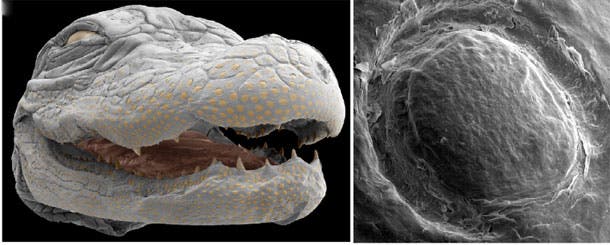Considering their heavy scale armor, and ferocious apatite, “sensitive” might not be the first adjective that comes to mind when describing crocodiles or alligators. A new study has sought to answer a long lasting riddle for biologists after it finally found the purpose of peculiar black spots or domes on crocodile and alligator heads. Apparently, these act as extremely sensitive sensors, that can sense touch or pressure 10 times better than the skin of a human’s fingertip.
Some 4000 such dots are present on alligator heads, particularly along their jaws, inside their mouths, and between their teeth. Crocs are even more gifted, as they also have dome sprinklings over parts of the rest of their bodies, thus amounting to 9000 dots in total. These formations were first described over a century ago and have since been known as integumentary sensory organs, or ISOs.
Despite scientists have known for a very long time that the domes pose a sensing function of some sort, the exact purpose and functionality has escaped them. Many studies have argued that these might act like salt sensors, helping crocs and alligators detect unsafe to drink water, or used to detect faint electrical signals given off by prey. No evidence has been provided, however.

Vanderbilt University grad student Duncan Leitch, along with his adviser biologist Ken Catania, took it upon themselves to provide an answer to this puzzling question. Leitch first took a croc-handling course – a baby croc-handling course that is – and order relatively small alligators from refuges and crocodiles from commercial breeders.
Bumps that turn the croc and alligator into perfect on the sly predators
When he cut away the domes, he uncovered a vast network of nerve endings, including touch receptors tuned specifically to pressure and vibration. He then tested the various other theories presented in studies that sought to define the ISOs function. The animals were inserted in saltwater of varying degree, but the ISOs nerve endings didn’t react. Then, a 9-volt battery was dipped into the water to create an electric field, but again nothing back at the croc’s end. Both leading theories were busted.
Instead, Leitch found that the nerves feeding into the ISOs end in a variety of touch sensors, after he found the domes responded to stimuli from von Frey filaments—hairlike, standardized wires used to gauge sensation levels. Actually, the black dotes on the animals’ faces are so sensitive that they can detect pressure too slight even for the filaments.
“My professor and I didn’t believe at first that they could be that reactive,” Leitch said. “We closed our eyes and tried to tickle each other with [the filaments] on our fingertips, and neither of us could even feel it.”
Ten times more sensitive than our fingertips
The researchers found that the most sensitive ISOs can sense forces as tiny as 78 millionths of a Newton or 10 times more sensitive than the most sensitive parts of our fingertips. This explains how crocs and alligators are able to detect ripples from even a single drop of water-and therefore even very weak prey movements, a theory for ISOs function first mentioned in 2002. To put the theory to the test, Leitch dropped pellets of food into the still tiny animals’ water tanks, all while in pitch black. He found that the crocs would almost instantly turn towards the food was, heads towards it, and bite it within 50-70 milliseconds after their skin touched it.
“This was exactly what I had hoped somebody would do with ISOs, in terms of really looking at the distribution and the electrophysiology, because that’s really the way to answer these questions about function in a tiny sense organ like this,” said Kent Vliet, co-chair of the Association of Zoos & Aquariums’ Crocodilian Advisory Group.
The sensors aren’t only used for feeding, though. A great proportion of these domes are present inside the animals’ mouth, between teeth especially. These would most likely serve to offer sensitivity to the mout to help their young out of their shells and to hold the offspring between their jaws for protection.
Next the researchers plan on studying why crocs also have these bumps on their bodies, not just their faces. Some people have speculated that the alligators have body ISOs buried deeper in their skin, but Leitch saw no evidence.
“What’s interesting to me is that such a scaly animal, one that’s so heavily armored, could have a sensitivity that rivals or surpasses our tactile abilities,” Leitch said. “But they have all these little tactile areas that are so exquisitely sensitive—it seems really amazing.”
Findings were published in the Journal of Experimental Biology.


